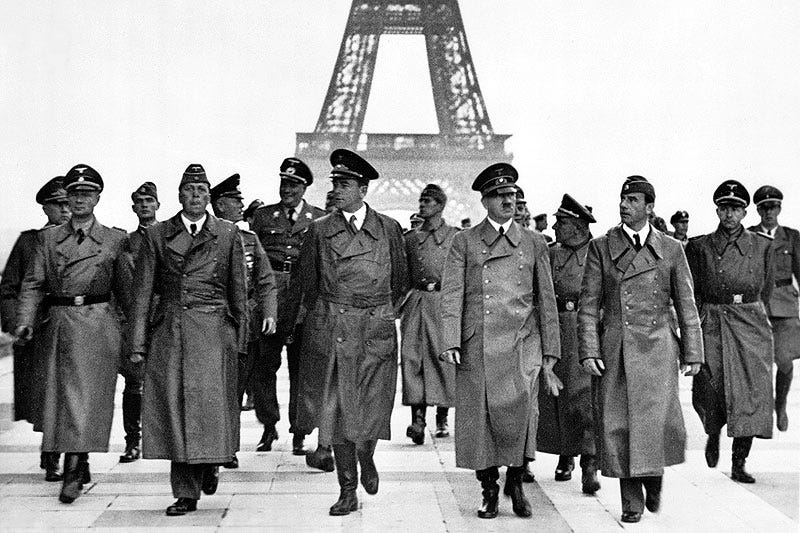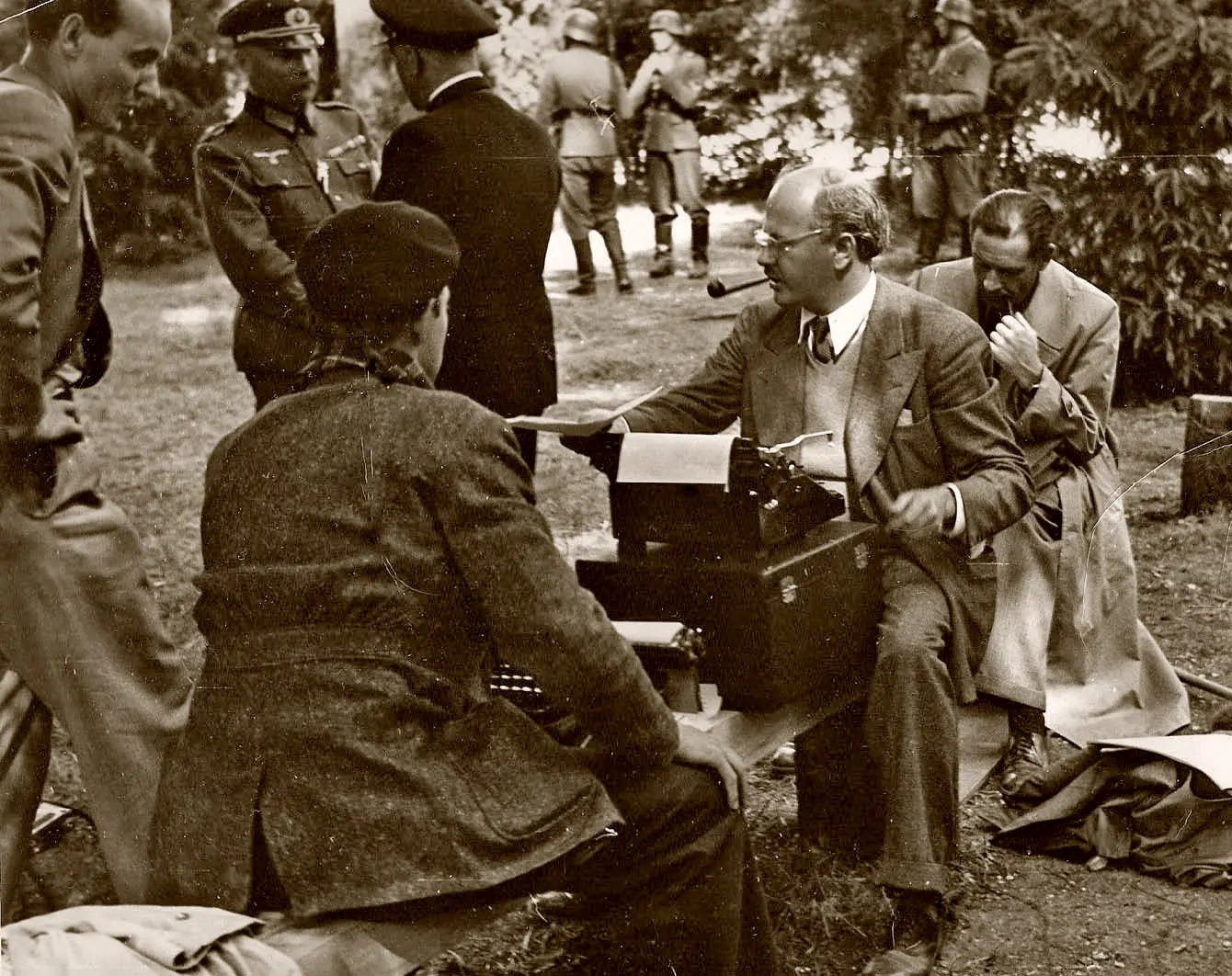Chapter 21: Victory in the West
In a matter of weeks, Hitler achieves total dominance in continental Europe and demands a humiliating and symbolic surrender

He had never visited Paris before. So it was only natural that when the opportunity presented itself he would visit its most famous landmarks. He found the visit to Napoleon’s tomb moving. For obvious reasons. But the most famous images from the trip were taken at Trocadéro, just across the Seine from the Eiffel Tower, which he visited like any other tourist.
Chances are most of you have been there at some point in your life. If you haven’t, you most certainly have seen pictures taken from the spot.
Trocadéro in the western part of Paris served as the center of World Fair festivities more than once. The hill on the northern side of the Seine (the “rive droite” or “right bank”) used to be a former village, Chaillot, with a wonderful view of everything below. From the World Fair in 1878 until 1937, the Trocadéro Palace stood atop the hill looking down across the Seine onto the left bank, where the Eiffel Tower stood after another World Fair.
For the International Expo of 1937, they tore the Trocadéro Palace down and built a new edifice, the Chaillot Palace. Notably, the two curved wings are not connected but instead an esplanade allows for pedestrians to move from the street or the metro directly to views of the Eiffel Tower. It is one of the most popular sites in Paris.
I remember when I first visited Paris in the fall of 2006, it was one of the first places I went as well. I met some friends with a bottle of wine, a baguette, and cheese, and we sat and had a small apéro while looking across the Seine at the Eiffel Tower.
Hitler’s participation in a form of this ritual is thus unsurprising. Everyone did it. Everyone still does it.
But Hitler’s visit was historically unique in the history of the Chaillot Palace. He came as a conqueror.
Twenty years earlier, he slept, ate, and fought in the trenches only a few dozen miles to the northeast. But the Germans never made it closer than the Marne, a river still several miles outside Paris. That formative experience in his 20s was the seed of so much bitterness and resentment that, once planted in the noxiously fertiles soil of anti-semitism and German nationalism, grew up to give the world Nazism. By June 1940, that political ideology had triumphed over France and all of continental Europe. Which is why Hitler and his entourage were doing sightseeing in Paris.
Today, we dive into chapter 21 “Victory in the West” of William Shirer’s The Rise and Fall of the Third Reich.
First off, my apologies again for the slow pace of these posts. The past month or so, I’ve had some illness or combination of illness I can’t quite shake. I now think I probably had Covid. Maybe some of the fatigue and fuzzy brain and nausea, which has weighed me down as of late is the aftereffects of what they call “long Covid”… I’m not sure, honestly. But it has gotten in the way of just about everything in life.
I thank you for sticking with me thus far and thanks for the small messages of appreciation and well wishes you’ve sent me privately.
In our last chapter, Shirer describes how the Nazis quickly overran both Norway and Denmark in order to better counter the United Kingdom.
And it was the United Kingdom, which was Nazi Germany’s primary enemy. The USSR had been safely neutered with the Molotov-Ribbentrop Pact. The rest of central Europe had been annexed or co-opted. Poland fell to German blitzkrieg in no time at all. Italy was an ally, even if a reluctant one at times. Sweden, Switzerland, and Spain were all neutral—for different reasons.
France and Britain, who had declared war on Germany after the invasion of Poland, were still in theory at war with Germany, even if the lack of real military engagement led many to call it a “phony war.”
Hitler believed for a long time that the two western European powers would make peace. For his part, delaying a major offensive against them was a tactic meant to encourage their eventual capitulation.
At the same time, though, he had his generals prepare “Fall Gelb,” a plan to attack the western front and take over France.
In May 1940, Nazi Germany followed those plans to a ‘T’. The Dutch, only lasted five days. Winston Churchill, who took over as Prime Minister on the first day of the battle, was baffled by how easy it was for the Germans. In a traditional means of defense honed over centuries, the Dutch flooded their water lines, but the Nazis just used parachutists and troops landed by air transports to get over the flooded water lines. Warfare had changed. And the Dutch hadn’t kept up.
Rotterdam surrendered shortly thereafter. Queen Wilhelmina and her government fled to London.
Belgium didn’t last much longer. German Panzers burst through the Ardennes and turned north. A combination of French, British, and Belgium forces were then trapped at Dunkirk against the North Sea. Their evacuation by sea is a story that has gone down as legend. The world knows it well from Churchill’s speech of defiance in its wake all the way through to later retellings like the 2017 film Dunkirk.
Shirer spends some time in this chapter trying to puzzle out why Germany did not advance directly while the Allied troops were trapped against the sea. He notes that he wrote General Halder to ask for “elucidation” and “promptly received a courteous and detailed reply.” Hitler, it seems, wanted the final battle to happen on French soil, not Flemish soil. The Germans had violated the neutrality of the Netherlands and Belgium, which Hitler knew but wanted to ignore. He had a pretext, as he always did, but he always liked to use the figleaf of the law when possible in the hope it would give him some cover in the court of international public opinion.
A week after the Nazi advance began, Churchill flew to Paris. He asked where the reserve troops were located. When the response came back, he was dumbfounded: “there are none.” An inauspicious omen.
On May 26, Operation Dynamo began. In the following week, over 300,000 soldiers escaped. On June 5, the Germans turned their attention to France. On June 10, the French government fled. And on the 14th, the Nazis entered Paris. Wilhelm II telegramed Hitler on June 17 to congratulate the Nazi leader on what he himself had been unable to do in four years of war.
The Italians joined belatedly to get in on the action in the Alps in the southeast of France. Later, the French and Italians signed a separate peace agreement.
It was the peace agreement between the French and Germans that showed the cruel and resentful nature of the Nazi leader, though. On June 21, the Nazis forced the French to surrender to them in the same railway car at Compiègne in which the Germans had surrendered to the French in 1918. William Shirer, still allowed to cover Nazi Germany for a while longer, accompanied the Nazi leaders to the grove north of Paris. A famous picture—the one chosen to grace the cover of Cuthbertson’s biography—shows him typing his report on the event outside atop a bench and the typewriter case.
After the conquest of France, Hitler’s dominance of continental Europe was unquestioned. Every country on the continent itself was directly controlled by the Germans, allied with it, or decidedly neutral.
Hitler assumed it would only be a matter of time until Britain also capitulated. As a result, he made no real plans. Shirer notes, “The Germans, despite their vaunted military talents, lacked any grand strategic concept.”
In what Shirer terms his “last great speech,” Hitler then addressed the German people on July 19, 1940. It was a typical speech but somehow calmer, full of self-congratulation. Hitler promoted many of his generals who had enabled the world-historical conquest of the European continent.
But Hitler lacked a strategic plan. In the enthusiasm at the victories they had racked up, there were no clear next steps.
Although some may think that the full extent of Hitler’s advances in 1942 marks his high point, perhaps it is better viewed as this moment in the summer of 1940. In a sense, the world is fortunate that Hitler was megalomaniacal. If had acted more strategically and more prudently from the summer of 1940 on, the Nazis might still be controlling large parts of Europe.
Of course, that was not to the case.
Topical Posts
Podcast ep. 1: The Man, The Myth: Hitler in American Culture
The Problems with the German Character Explanation of the Nazis
Podcast ep. 2: Why are Dictators (and Techno-monarchs) Appealing?
Podcast ep. 3: Interview with a 20th Century War Correspondent: Jon Randal
If You’ve Fallen Behind on the Reading, This Post is For You
Who was William L. Shirer? — part 2 (The Nightmare Years 1934-1940)
Podcast ep. 4: The Exhilaration & Peril of Covering the Nazis (with Prof. Michael Socolow) (Video, Audio)
Podcast ep. 5: What American Reporters Saw That Others Didn't (with Prof. Deborah Cohen) (Video, Audio)
80 Years On: A Reflection on History and Journalism As We Commemorate the End of World War II




